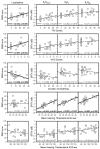Effect of Tinnitus and Duration of Deafness on Sound Localization and Speech Recognition in Noise in Patients With Single-Sided Deafness
- PMID: 30509148
- PMCID: PMC6291880
- DOI: 10.1177/2331216518813802
Effect of Tinnitus and Duration of Deafness on Sound Localization and Speech Recognition in Noise in Patients With Single-Sided Deafness
Abstract
Patients with single-sided deafness (SSD) often experience poor sound localization, reduced speech understanding in noise, reduced quality of life, and tinnitus. The present study aims to evaluate effects of tinnitus and duration of deafness on sound localization and speech recognition in noise by SSD subjects. Sound localization and speech recognition in noise were measured in 26 SSD and 10 normal-hearing (NH) subjects. Speech was always presented directly in front of the listener. Noise was presented to the deaf ear, in front of the listener, or to the better hearing ear. Tinnitus severity was measured using visual analog scale and Tinnitus Handicap Inventory. Relative to NH subjects, SSD subjects had significant deficits in sound localization and speech recognition in all listening conditions ( p < .001). For SSD subjects, speech recognition in noise was correlated with mean hearing thresholds in the better hearing ear ( p < .001) but not in the deaf ear. SSD subjects with tinnitus performed poorer in sound localization and speech recognition in noise than those without tinnitus. Shorter duration of deafness was associated with greater tinnitus and sound localization difficulty. Tinnitus visual analog scale and Tinnitus Handicap Inventory were highly correlated; the degree of tinnitus was negatively correlated with sound localization and speech recognition in noise. Those experiencing noticeable tinnitus may benefit more from cochlear implantation than those without; subjective tinnitus reduction may be correlated with improved sound localization and speech recognition in noise. Subjects with longer duration of deafness demonstrated better sound localization, suggesting long-term compensation for loss of binaural cues.
Keywords: duration of deafness; single-sided deafness; sound localization; speech recognition in noise; tinnitus.
Figures





Similar articles
-
Binaural Perception in Single-Sided Deaf Cochlear Implant Users with Unrestricted or Restricted Acoustic Hearing in the Non-Implanted Ear.Audiol Neurootol. 2018;23(3):187-197. doi: 10.1159/000490879. Epub 2018 Oct 23. Audiol Neurootol. 2018. PMID: 30352440
-
Benefits of Cochlear Implantation for Single-Sided Deafness: Data From the House Clinic-University of Southern California-University of California, Los Angeles Clinical Trial.Ear Hear. 2019 Jul/Aug;40(4):766-781. doi: 10.1097/AUD.0000000000000671. Ear Hear. 2019. PMID: 30358655 Clinical Trial.
-
The effect of simulated unilateral hearing loss on horizontal sound localization accuracy and recognition of speech in spatially separate competing speech.Hear Res. 2018 Jan;357:54-63. doi: 10.1016/j.heares.2017.11.008. Epub 2017 Nov 22. Hear Res. 2018. PMID: 29190488
-
Implantable Devices for Single-Sided Deafness and Conductive or Mixed Hearing Loss: A Health Technology Assessment.Ont Health Technol Assess Ser. 2020 Mar 6;20(1):1-165. eCollection 2020. Ont Health Technol Assess Ser. 2020. PMID: 32194878 Free PMC article.
-
Cochlear Implantation Outcomes in Adults With Single-Sided Deafness: A Systematic Review and Meta-analysis.Otol Neurotol. 2023 Apr 1;44(4):297-309. doi: 10.1097/MAO.0000000000003833. Epub 2023 Feb 15. Otol Neurotol. 2023. PMID: 36791341
Cited by
-
Bilateral gene therapy in children with autosomal recessive deafness 9: single-arm trial results.Nat Med. 2024 Jul;30(7):1898-1904. doi: 10.1038/s41591-024-03023-5. Epub 2024 Jun 5. Nat Med. 2024. PMID: 38839897 Free PMC article. Clinical Trial.
-
Sound Localization in Single-Sided Deafness; Outcomes of a Randomized Controlled Trial on the Comparison Between Cochlear Implantation, Bone Conduction Devices, and Contralateral Routing of Signals Hearing Aids.Trends Hear. 2024 Jan-Dec;28:23312165241287092. doi: 10.1177/23312165241287092. Trends Hear. 2024. PMID: 39470034 Free PMC article. Clinical Trial.
-
Proficiency in Using Level Cue for Sound Localization Is Related to the Auditory Cortical Structure in Patients With Single-Sided Deafness.Front Neurosci. 2021 Oct 11;15:749824. doi: 10.3389/fnins.2021.749824. eCollection 2021. Front Neurosci. 2021. PMID: 34707477 Free PMC article.
-
The interference of tinnitus on sound localization was related to the type of stimulus.Front Neurosci. 2023 Feb 7;17:1077455. doi: 10.3389/fnins.2023.1077455. eCollection 2023. Front Neurosci. 2023. PMID: 36824213 Free PMC article.
-
Speech, Spatial, and Qualities of Hearing Scale and Tinnitus Functional Index Improvements After Cochlear Implant Surgery for Single-Sided Deafness.Laryngoscope Investig Otolaryngol. 2025 Apr 22;10(2):e70090. doi: 10.1002/lio2.70090. eCollection 2025 Apr. Laryngoscope Investig Otolaryngol. 2025. PMID: 40264920 Free PMC article.
References
-
- Arndt S., Aschendorff A., Laszig R., Beck R., Schild C., Kroeger S., Wesarg T. (2011) Comparison of pseudobinaural hearing to real binaural hearing rehabilitation after cochlear implantation in patients with unilateral deafness and tinnitus. Otology & Neurotology 32(1): 39–47. doi:10.1097/MAO.0b013e3181fcf271. - PubMed
-
- Arts R. A., George E. L., Stokroos R. J., Vermeire K. (2012) Review: Cochlear implants as a treatment of tinnitus in single-sided deafness. Current Opinion in Otolaryngology & Head and Neck Surgery 20(5): 398–403. doi:10.1097/MOO.0b013e3283577b66. - PubMed
-
- Bosman A. J., Hol M. K., Snik A. F., Mylanus E. A., Cremers C. W. (2003) Bone-anchored hearing aids in unilateral inner ear deafness. Acta Oto-Laryngologica 123(2): 258–260. doi:10.1080/000164580310001105. - PubMed
-
- Buechner A., Brendel M., Lesinski-Schiedat A., Wenzel G., Frohne-Buechner C., Jaeger B., Lenarz T. (2010) Cochlear implantation in unilateral deaf subjects associated with ipsilateral tinnitus. Otology & Neurotology 31(9): 1381–1385. doi:10.1097/MAO.0b013e3181e3d353. - PubMed
Publication types
MeSH terms
Grants and funding
LinkOut - more resources
Full Text Sources
Medical

